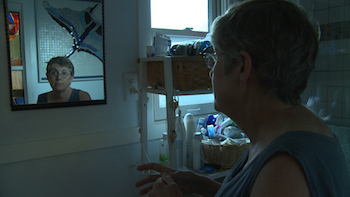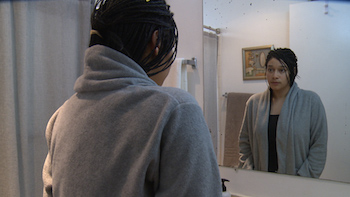
Therapist Explores Her Own Experiences with Dissociative Identity Disorder in Documentary
Our minds work in incredible ways to protect us from the negative experiences that occur throughout our lives. Those diagnosed with dissociative identity disorder (DID) show us just how resilient we can be in surviving severe trauma and/or abuse.
The documentary “Busy Inside” follows Karen Marshall, a licensed clinical social worker and therapist specializing in DID. Marshall has been diagnosed with DID herself and uses her personal experience to guide her clients through the healing process. The film shows both Marshall and her clients in professional and personal settings, providing us with an intimate look into the daily lives of people experiencing this disorder.

Still of Karen Marshall from “Busy Inside”
The film’s director, Olga Lvoff, shares her decision to focus on personal experience rather than expert opinion. She explains the film as “a window into the world of how people with DID live. You are able to just be with them.”
The viewing experience of the film is profound. It humanizes those with DID as we’re able to share in their everyday trials and triumphs. The intimate nature of the film prompts us to question how our own brains and inner worlds are constructed. “It allows us to reflect upon the many factors that go into our understanding of reality.” says Lvoff.
In an interview with the Trauma & Mental Health Report (TMHR), Marshall provides an explanation of DID:
“Dissociative identity disorder is the experience of having two or more unique and separate personalities existing within one body. The different parts function as individuals in some way.”
DID develops as a coping mechanism to long-term and severe childhood trauma. While experiencing disturbing things, a child can disconnect from their physical bodies in a mental process known as “dissociation.” To protect themselves from harm, parts of the self can split off into different personalities. This is to prevent the whole self from remembering and reliving traumatic experiences. These different personalities, sometimes referred to as “alters,” can reflect the different developmental stages in which the abuse has occurred, which is why many alters appear as children. Marshall shares her insight into the complexity of these internal lives:
“In these scenarios, kids never had the chance to be kids. This is why healing the young ones inside is so important. It can be helpful to develop an inside world that includes treehouses or waterfalls, anything the children alters would enjoy.”
For those who have DID, Marshall describes that it can be difficult to separate present and past because parts of them vividly feel as though they are still being traumatized. Marshall describes to us her own experience with DID:
“I realized something was going on with me, but I couldn’t pinpoint exactly what it was. It came to a head after a really hard week. I felt like a revolving door, like all these different parts were coming out and I had no control over any of it. I would pull it together for whatever I had to do, fall apart when back at home, then get up and do it all again. This happened until I found a therapist that understood how to work with DID.”
Lvoff shares the importance of having positive media representation of those with DID. She notes that this is why many participants chose to appear in the film, as “they felt like the media has sensationalized DID and their voices were not represented.” Similarly, Marshall expresses that she thinks “people are afraid of those with DID. Afraid that a part is going to come out that wants to hurt others. Although, they are often more self-destructive rather than other destructive.”
Marshall explains her thoughts on the labelling of dissociation as a disorder and the process of diagnosis:
“For some people, it gives them a reason to accept their experience and understand why it doesn’t make sense. Somehow there needs to be permission to have the problems.”
Rosalee, an alter who shares “the body” with Marshall, adds:
“If the name given by a diagnosis doesn’t fit, we don’t care, it’s for insurance purposes anyway. It does make a difference in how we work with you, but we’ll figure it out, we can come up with a different name.”
Marshay, one of Karen’s clients featured in “Busy Inside,” had the challenge of accepting her DID diagnosis throughout the film. Rosalee explains that this can be a difficult process to undergo:
“Acceptance means dealing with the fact that there was something very unpleasant that happened. Sometimes people can’t go to that dark place, so they fight it tooth and nail.”

Still of Marshay from “Busy Inside”
Marshall describes how her DID diagnosis shapes the way she interacts with her clients during therapy:
“I can come up with all kinds of ways to help people, although they may not like them. In that case, it’s okay, we’ll find a different way. With Marshay for example, we refer to the different personalities as rainbow colours because that’s what works for her.”
After spending a lot of time examining their trauma and deep diving into the past, Rosalee describes how the different parts within “the body” can now have fun and experience happiness. They note:
“We don’t want to be one person. We don’t know how, and it doesn’t make any sense. How do you become one? We know how to be many, but we don’t know how to be one.”
Watch the Trailer to “Busy Inside” here: https://vimeo.com/348442623
“Busy Inside” will be streaming online upon premiere on March 16th at 8pm ET at worldchannel.org, amdoc.org, and on all station-branded PBS platforms through to April 15th at 11:59pm ET. https://worldchannel.org/episode/america-reframed-busy-inside/ (or use this shortcut bit.ly/ARF_BusyInside) for the stream.
To access the film for educational distribution among universities, conferences and libraries: https://www.newday.com/film/busy-inside
-Chiara Gianvito, Contributing Writer
Image Credits:
Feature: Jr Korpa at Unsplash, Creative Commons
First: Provided by “Busy Inside” PR
Second: Provided by “Busy Inside” PR



